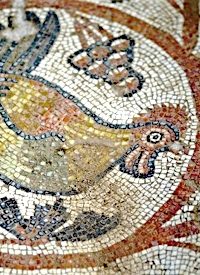
In early February archeologists in Israel unveiled a fascinating discovery in the Judean hills some 20 miles southwest of Jerusalem: a newly uncovered 1,500-year-old Christian church, complete with a well-preserved mosaic floor bearing images of lions, foxes, fish, and peacocks.
The small Byzantine church, which was excavated over a two-month period, had been used between the fifth and seventh centuries, explained Amir Ganor of the Israel Antiquities Authority. He called the decorative floor “one of the most beautiful mosaics to be uncovered in Israel in recent years.”
According to the Associated Press, archaeologists began carefully excavating the site after officials from the Antiquities Authority discovered that thieves had already been plundering the ruins for treasures to sell.
“Though an initial survey suggested the building was a synagogue, the excavation revealed stones carved with crosses, identifying it as a church,” reported the AP. “The building had been built atop another structure around 500 years older, dating to Roman times, when scholars believe the settlement was inhabited by Jews.”
Underneath the ancient basilica, archaeologists discovered a network of tunnels they speculate were used by Jews fighting against Roman troops during the second century A.D. “Stone steps lead down from the floor of the church to a small burial cave,” reported the AP, “which scholars suggest might have been venerated as the burial place of the Old Testament prophet Zecharia[h].”
While archaeologists have uncovered many sites in Israel over the years, including Crusader, Islamic, Byzantine, Roman, ancient Jewish, and even prehistoric ruins, antiquities expert Shai Bar-Tura told the Christian Broadcasting Network that the well-preserved nature of the church’s floor makes these ruins special.
“The best way to see this is by looking at the mosaic floor, which is … magnificent …,” he said. “There are intricate geometrical designs. We see wonderful wild scenes with wild animals, fish swimming in a pond. There’s another spectacular scene of a lion hunting a gazelle.” In addition, he reported, marble columns imported from Turkey grace the central hall of the church.
“One of the most wonderful things about archaeology and especially about sites like these is the visitor coming to this church uncovered now basically walks into the same building and sees the same things that Christian worshipers would have seen 1,500 years ago,” Bar-Tura said.
Officials of the Antiquities Authority indicated that after thorough exploration and analysis, the ruins would be carefully re-covered with layers of sand and fabric to protect them against further plundering, with plans to eventually reopen the site to the public and tourists.
Photo: A detail of a mosaic in the archaeological site where an ancient church was found in Hirbet Madras, central Israel, Feb. 2, 2011: AP Images



